Exploring International City: A Multicultural Oasis in Dubai
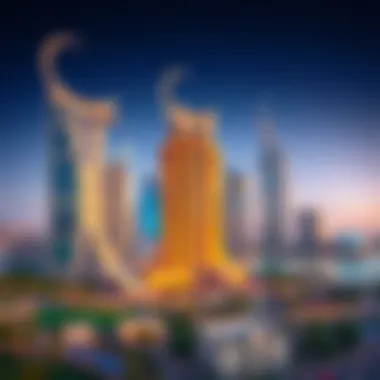
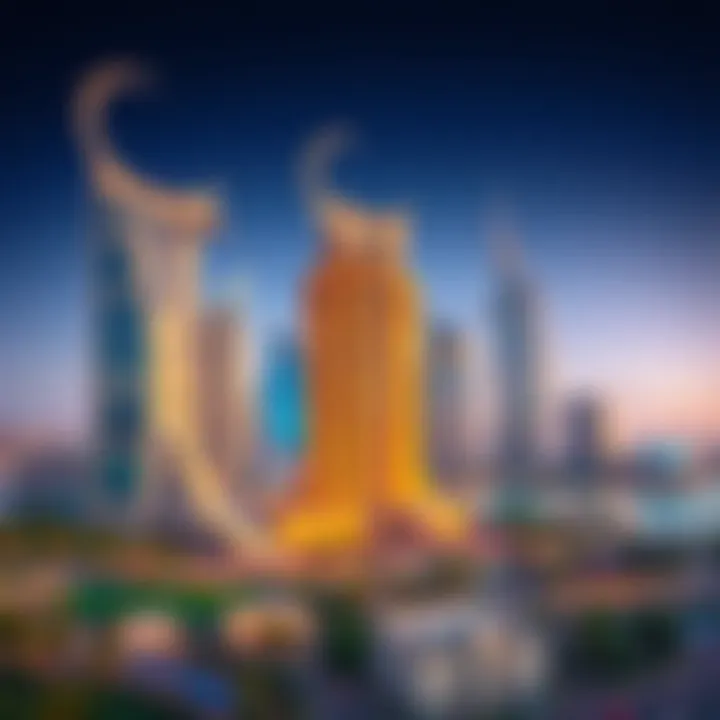
Intro
Dubai has gained a reputation as a global melting pot, a place where cultures collide and converge. Amid all the grandeur, the International City stands out as a significant component of this multicultural mosaic. As you stroll through its winding paths, a sense of dialogue and understanding among diverse populations surrounds you. It's not merely an area to reside; it’s a lively community that offers a distinctive lifestyle, catering to its inhabitants from all corners of the globe.
In this article, readers will embark on an enlightening journey through the International City, examining its unique architecture, vibrant community life, and the amenities it has to offer. By delving deep into this urban oasis, one can appreciate the rich cultural narrative that unfolds in daily life and get a glimpse into its promising future.
Let's first take a look at the neighborhood features that not only define this urban enclave but also reflect its multicultural character.
Neighborhood Features
Landscaping Highlights
One of the first things that strike you upon entering the International City is its well-planned landscaping. Carefully crafted green spaces punctuate the urban environment, offering residents and visitors alike a breath of fresh air amidst the concrete and brick. Parks are festooned with flowering shrubs and trees that provide shade, making it a perfect spot for family picnics or a serene stroll.
The designers paid keen attention to creating an aesthetic appeal, where beauty marries function. Paths lined with palm trees lead to communal gardens, where locals often gather. It’s not unusual to spot children playing, or a group of friends huddled around a BBQ grill, creating a sense of togetherness that is palpable.
Architectural Styles
The architecture in the International City reflects a myriad of styles, emphasizing its identity as a global hub. Structures inspired by various cultural motifs are scattered throughout. You might encounter designs that nod to Arabic styles, coupled with touches that bring in Far Eastern influences, and even hints of European flair. This eclectic mix sets a remarkable tone as one traverses the area.
Residential buildings often display vibrant colors and decorative elements that pay homage to the various cultures represented. This artistic endeavor creates not just homes, but an experience; every window displays a story, and every building is a piece of the larger cultural puzzle.
The thoughtful integration of these diverse architectural styles serves as a constant reminder of the area’s commitment to inclusivity and respect for cultural variance.
Community Life
Local Events and Activities
What truly breathes life into the International City is its community vibe, amplified by year-round events that celebrate diversity. Festivals often showcase music, dance, and culinary arts from different regions, allowing residents to share their heritage and traditions. These vibrant gatherings foster an environment of tolerance and appreciation.
From street fairs filled with food stalls offering dishes from around the world to art exhibitions featuring local talents, there’s never a dull moment. Weekly markets bring people together, encouraging neighborly interaction, while cultural events create bonds that transcend national borders.
Lifestyle Amenities
To complement its colorful community life, the International City boasts a generous array of amenities that cater to all residents. Grocery stores filled with international products cater to the varied culinary preferences, while cafes and restaurants serve everything from shawarma to sushi.
Educational facilities, healthcare centers, and recreational hubs can be spotted throughout the area, ensuring that the community's practical needs are met. For fitness enthusiasts, well-equipped gyms and sports fields provide ample opportunities to stay active and engaged.
With all these features, the International City doesn't just serve as a residential area; it’s a thriving ecosystem where every element, from the architecture to the community events, creates a harmonious living environment. Each nuance contributes to an ever-evolving narrative that embraces complexity while fostering unity.
The International City is a testament to what can happen when cultures come together, shaping a unique identity that reflects their stories and aspirations.
For more information about life in Dubai’s International City, you can visit Dubai Land Department or explore community discussions at platforms like Reddit.
Stay tuned as we further explore the future prospects of this dynamic urban landscape, and unveil more about the lifestyle that awaits.
Intro to International City
Understanding the International City in Dubai is essential for grasping the urban development landscape in this area. This district is not merely a residential zone; it serves as a melting pot of cultures, traditions, and lifestyles. It’s a place where the global and local merge, creating a vibrant community that is both welcoming and unique.
Living or visiting International City provides opportunities to engage with diverse cultures while enjoying modern amenities and services. For homeowners, this location represents a chance to tap into a multi-faceted lifestyle, with leisure options ranging from parks and shops to cultural exchange.
Overview of International City
International City spans over 800 hectares and is designed with various themed architectural clusters representing different countries. This makes each corner of the city a mini-cultural experience. The district includes 10 distinct sectors, each named after a country and offering a reflection of that nation's vernacular architecture.
Some of the key features of this area include:
- Affordable living options: With a variety of apartments, it attracts a broad demographic, from expatriates to local residents.
- Cultural markets and dining: Visitors and residents alike can enjoy foods from all around the world, enhancing the cultural tapestry.
- Transport connectivity: Proximity to key highways makes accessing other parts of Dubai a breeze.
International City is more than just a geographical location; it embodies the spirit of integration and diversity, making it pivotal in the broader context of Dubai’s expansion.
Historical Development
The establishment of International City dates back to the late 1990s when Dubai aimed to diversify its economy and accommodate the growing expatriate population. Initially envisioned as a low-cost housing project, it quickly evolved into a visionary platform for cultural exchange and residential living.
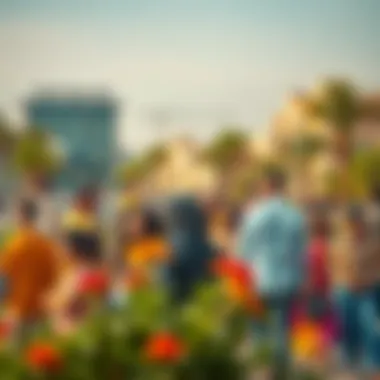
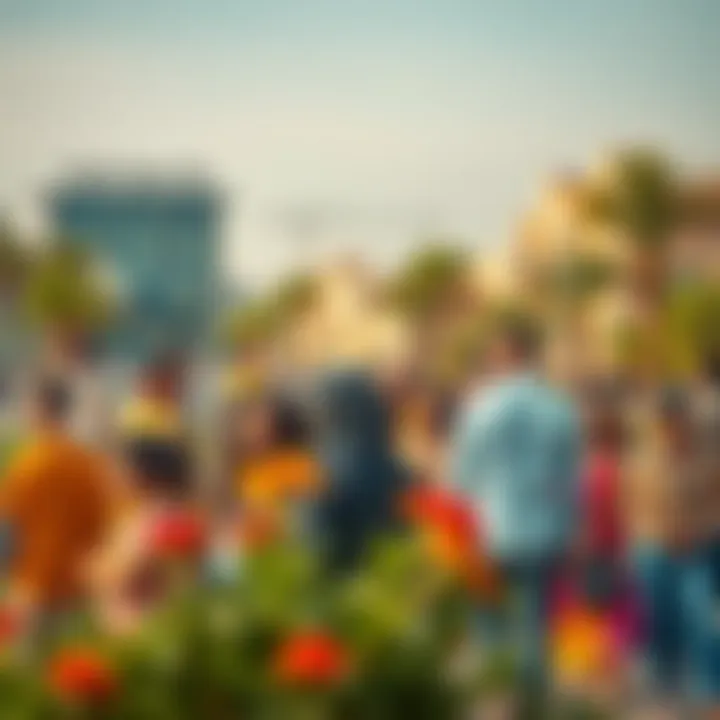
In 2002, the first residential units were completed, and the district gradually expanded to include vital infrastructure like schools, supermarkets, and recreational facilities. The development was strategically aligned with Dubai's ambition to become a global hub for tourism and business.
Over the years, International City has undergone significant transformations:
- 2003: Cultural themes introduced, marking the first major aesthetic development in the area.
- 2004-2010: Construction boomed, with residential properties springing up in response to demand.
- Present Day: Today, it encompasses over 60,000 apartments, a diverse population, and significant economic activity. This growth has positioned International City as a key player in Dubai's urban development narrative.
"International City symbolizes the fabric of a global society, creating connections through shared experiences and interactions among its residents."
By examining the factors that have influenced its evolution, we can appreciate the ongoing legacy and future prospects of this dynamic locale in the heart of Dubai.
Cultural Diversity and Community Life
The concept of cultural diversity is foundational to understanding the vibrancy of International City in Dubai. This area embodies a rich tapestry woven from the threads of numerous cultures, where different backgrounds intersect to form a kaleidoscope of human experience. In this section, we will explore the demographics, cultural festivals, and community engagement initiatives that characterize this unique urban space.
Demographics and Population Overview
Dubai's International City is a melting pot, serving as the residence for individuals from over 165 nationalities. With a population of roughly 70,000, the community reflects a variety of ethnicities, languages, and traditions. The most populous groups include South Asians, Arabs, and Africans, but Eastern Europeans and several Western nationals make their home here too.
This demographic mix not only creates a lively atmosphere but also brings about some challenges in terms of integration and community cohesion. Shared experiences are often derived from common values and traditions, yet the distinct cultural identities remain pronounced. For instance, food is an important part of life, as local eateries showcase culinary styles from around the globe – Indian curry houses sit next to Lebanese shawarma joints, offering residents and visitors a taste of home, no matter where that may be.
Cultural Festivals and Events
Cultural festivals in International City are a reflection of its diverse populace. Events celebrate major cultural and religious holidays, allowing residents to share their heritage with others. For instance:
- Diwali: The Festival of Lights attracts people from all over, with lights, fireworks, and traditional sweets.
- Eid Celebrations: Marked by communal prayers, feasts, and family gatherings; this celebration brings together both residents and visitors to engage in communal activities.
- Chinese New Year: A lively event featuring dragon dances, traditional food stalls, and craft activities that promote understanding of this important cultural tradition.
The diversity of these events fosters an environment of mutual respect and knowledge. It paves the way for younger generations to appreciate their heritage while becoming more open-minded towards others.
Community Engagement and Activities
Community engagement is crucial for any multicultural society aiming for cohesion. In International City, a variety of activities encourage interaction among residents. Local organizations often set up workshops and classes that might include:
- Language Exchange Programs: Offering opportunities for residents to learn new languages while sharing their own.
- Sports Leagues: They include cricket, basketball, and football teams, which provide a platform for teamwork and camaraderie.
- Art Exhibitions: Local artists display their work, showcasing a blend of cultures that reflect the community’s diversity.
Such activities not only promote social connections but also help residents to traverse cultural boundaries. When people come together in these settings, they cultivate friendships and create a sense of belonging, which is vital to fostering a thriving community.
"Cultural diversity is not a reason for conflict. It is a reason for celebration."
By embracing the cultural diversity present in International City, residents contribute to a community that is not just a collection of individuals but a collective engaged in continuous learning and growth. The benefits that arise from this multicultural interaction are considerable, driving innovation and enhancing mutual appreciation among its populace.
In summary, the cultural diversity and community life in International City serve as a vital backbone of its identity, promising a rich lifestyle for both current homeowners and potential visitors. This understanding sets the stage for further exploration of the architectural themes and amenities that enhance the living experience here.
Architectural Themes and Landscape Design
In a city like Dubai, where the skyline tells diverse stories, the Architectural Themes and Landscape Design of the International City play a crucial role in defining its identity. This area presents a tapestry of unique building styles and green spaces that not only enhance the aesthetic appeal but also contribute to the livability and functionality of the urban landscape. Understanding these elements is vital for anyone interested in the architectural beauty and community spirit that characterize this international hub.
Unique Architectural Styles
The architectural landscape of International City is a vivid mix of influences that reflect its multicultural fabric. The buildings draw inspiration from various regions, creating distinct clusters such as the China, Russia, and Italy districts. Each area showcases styles that resonate with their respective cultures, ranging from traditional Chinese pagoda facades to contemporary Russian high-rise designs. This fusion of architecture is more than just eye candy—it serves to foster a sense of identity among its residents.
- Cultural Representation: The distinct architectural styles not only enhance property diversity but also provide residents with a slice of their heritage.
- Visual Appeal: The unique designs contribute to the city's overall aesthetic, making it a cosmopolitan center that attracts global visitors.
This eclectic mix is not merely for decoration; it fosters a feeling of belonging and community among its diverse residents, enhancing social interactions and cultural exchanges.
Green Spaces and Landscaping Features
Adding a layer of tranquility to the urban environment, the green spaces in International City are thoughtfully integrated with the architectural designs. Parks, gardens, and recreational zones offer respite from the hustle and bustle while enhancing the quality of life for its residents.
"The inclusion of parks in urban design is essential; they are not just for beauty but for mental and physical well-being."
Benefits of Green Spaces:
- Environment Management: They help regulate temperature and manage rainwater.
- Community Hub: Parks become gathering spots for picnics, events, and social gatherings.
- Enhanced Biodiversity: Incorporating native plants supports local wildlife.
The landscaping is planned meticulously, often incorporating desert flora that thrives in the local climate. These features, along with walking paths and recreational facilities, encourage an active lifestyle and foster community interaction.
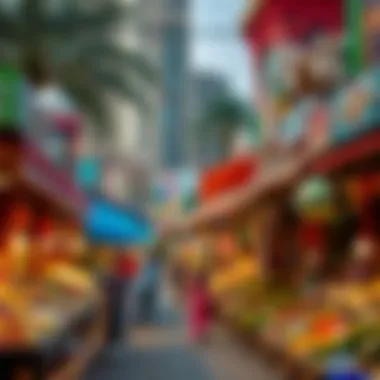
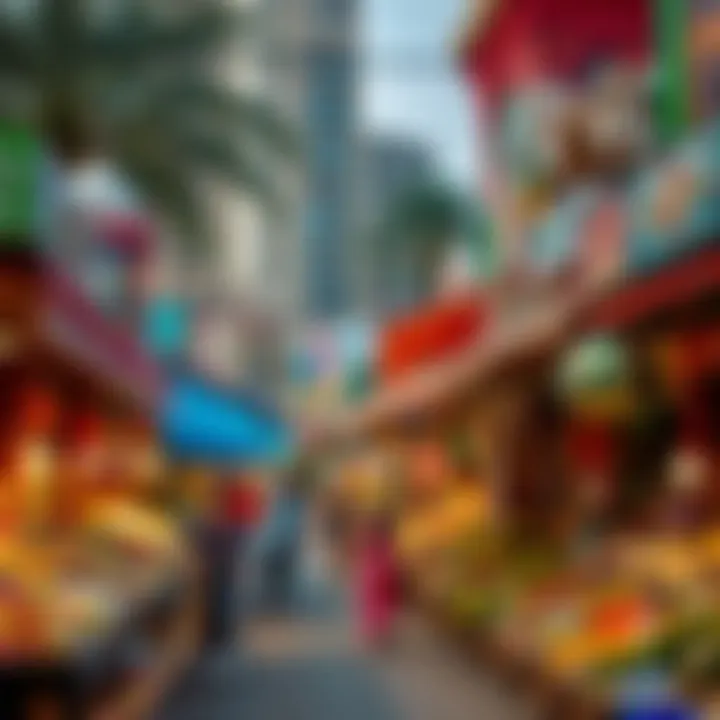
Planned Urban Layout
The layout of International City is another testament to effective urban planning. Designed with a purpose, the streets are organized logically, allowing residents to navigate easily. This layout not only promotes connectivity but also supports the flow of daily life.
Key Considerations in Urban Layout:
- Accessibility: Well-planned transportation links, including roads and public transport, ensure easy access to essential services and amenities.
- Mix of Uses: Incorporating residential areas, retail spaces, and recreational facilities within proximity facilitates a convenient lifestyle.
- Safety and Community Focus: Streets are designed to enhance safety, with pedestrian-friendly zones encouraging walking and a sense of community.
This thoughtful arrangement ensures that everything is within reach, whether it's a leisurely walk to a park or a quick trip to a local market. The emphasis on accessibility and functionality enhances the urban experience, making it appealing to homeowners, visitors, and urban planners alike.
The architectural themes and landscape design of the International City together create a unique environment that caters to diverse lifestyles. It is this blend of beauty, functionality, and community spirit that makes Dubai's International City a standout example of modern urban development, inviting exploration and engagement for all who wander its streets.
Amenities and Facilities
Amenities and facilities play a pivotal role in enhancing the quality of life in any urban environment. In Dubai's International City, this concept is magnified, making it a favored locale for both residents and visitors. Access to a wide array of essential services and recreational options significantly influences the desirability of a community, and International City is no exception.
Educational Institutions
Educational institutions are the bedrock of any thriving community. In International City, there is a range of choices, from primary schools to higher education establishments. For instance, the International School of Arts & Sciences caters to a diverse student body, offering a curriculum that respects multiple cultural perspectives. Parents can find several nurseries and kindergartens, which are crucial for early childhood development. Access to quality education attracts families and ensures that the community remains dynamic and engaged.
- Key features of educational institutions in International City:
- Multilingual programs accommodate various nationalities.
- Extracurricular activities promote holistic development.
- Proximity to residential areas encourages parental involvement.
Healthcare Services
Healthcare services are another cornerstone of livability. International City is not lacking in this department. The area hosts a variety of clinics and hospitals, where residents can receive necessary medical attention. The community's health centers focus on both preventive and curative care. For instance, the Aster Clinic is a familiar name, providing comprehensive outpatient services. The availability of healthcare ensures peace of mind, fostering a sense of security among residents.
"Access to quality healthcare impacts not only individual well-being but also the community's overall health profile."
- Considerations for healthcare services include:
- Multispecialty clinics that cater to diverse patient needs.
- Emergency services that ensure prompt medical response.
- Health awareness programs that encourage preventive care.
Recreational Amenities
Recreational amenities are indispensable for promoting a balanced lifestyle. International City offers a variety of parks and community centers, providing spaces for leisure and social interaction. One can find green areas designed for family picnics, jogging, or simply unwinding after a hectic day. Additionally, sporting facilities cater to those interested in a more active lifestyle, with options like basketball courts and outdoor gym equipment.
- Some notable recreational facilities in the area include:
- Duck Pond Park, a serene environment to relax.
- Community events that foster cultural exchange.
- Dedicated spaces for children to play safely.
In essence, International City offers a blend of amenities and facilities that cater to a multicultural population. By understanding the needs and preferences of its residents, the area stands as a model for urban development that prioritizes community well-being and lifestyle enrichment.
Real Estate and Investment Opportunities
Understanding the real estate landscape in the International City, Dubai, is like peeking into a kaleidoscope of vibrant opportunities. This area, known for its multicultural vibe, also serves as a significant hub for property investment and real estate transactions. By reviewing several aspects such as residential properties, current market trends, and the overall investment climate, potential buyers and investors can pinpoint their ideal aspirations.
Residential Property Overview
The residential property market in International City presents a unique array of options, tailored notably for varied preferences and budgets. Potential residents can choose between studio apartments, 1-bedroom and 2-bedroom units that reflect a mixture of affordability and luxury. Key communities like France Cluster and England Cluster offer distinct architectural styles, appealing to those looking for a culturally rich environment.
- Affordability: Compared to other Dubai areas, property prices here tend to be more reasonable, making it an attractive option for first-time buyers.
- Diversity of Units: Various apartment sizes ensure that whether you’re a solo traveler or a family, there are suitable accommodations.
- Amenities Access: Many residential units come coupled with essential amenities, such as swimming pools, gyms, and retail options, creating a holistic living experience for the residents.
Market Trends and Insights
Incorporating local market dynamics, the real estate scene in International City is influenced by broader economic factors, resident demographics, and lifestyle preferences. Recently, there's been a noticeable uptick in interest from expatriates, which results in growing demand for rental properties.
- Rising Popularity: The area has seen a surge in inhabitants due to more affordable living arrangements, thus increasing the rental market.
- Long-Term Investment: Investors find that homes in such multicultural communities tend to hold value well—offering capital appreciation alongside rental returns.
- Future Developments: Upcoming projects such as new shopping centers and schools signify ongoing growth, promising to enhance the attractiveness of the area for residents and investors alike.
"The International City is not just a dwelling place but a canvas for cultural confluence and architectural expression."
Investment Climate and Regulations
Prospective investors can feel optimistic about the regulatory framework governing real estate in the International City. Dubai’s government actively promotes real estate investment with procedures designed to ensure transparency and ease of access.
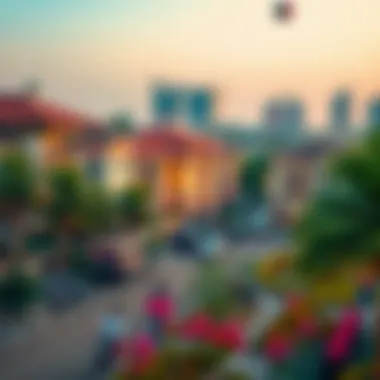
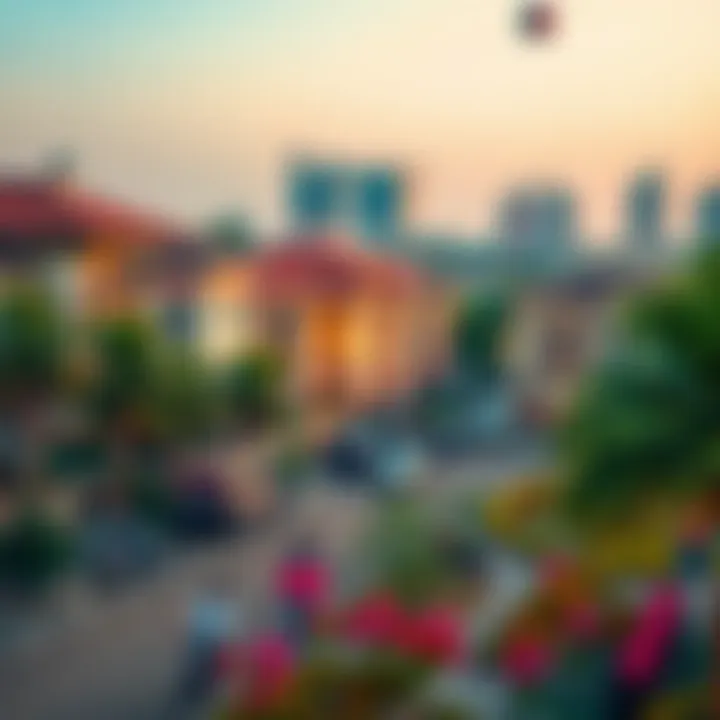
- Ownership Rights: Foreign nationals can freely purchase properties, with some limitations depending on the types of developments.
- Property Laws: Regulations are clearly laid out, governing everything from sales processes to dispute resolutions, providing a safety net for investors.
- Government Incentives: Programs aimed at attracting foreign investment contribute to a favorable atmosphere for real estate ventures.
Engaging in the real estate market in International City doesn’t merely yield financial returns; it offers an opportunity to be part of a diverse community, steeped in culture and lifestyle, rewarding those who invest in both receipts and experiences.
For further insights and potential properties, tools, and regulations, visit resources such as Wikipedia, Britannica, or stay updated through community discussions on platforms like Reddit.
Understanding real estate trends and knowing where to invest is a thriving journey, and with an ever-evolving landscape like the International City, opportunities are plentiful.
Connectivity and Transportation
The role of connectivity and transportation in shaping the experience of living or visiting International City in Dubai cannot be overstated. This vibrant establishment boasts various transportation options that serve as the lifeline for its diverse population. Accessibility is crucial, not just for daily commuting but also for enhancing the engagement of residents with the broader UAE. Here, we will explore the public transportation options available and the road networks that ensure seamless connectivity.
Public Transportation Options
International City is well-linked to Dubai's extensive public transport system, which is vital for both residents and visitors. When it comes to public transportation, the options are both practical and economical.
Dubai Metro is perhaps the most significant asset in the public transit landscape. The nearest metro station, Al Nahda, provides easy access to various parts of the city, fostering a sense of convenience for those wishing to travel to job centers, shopping malls, or leisure spots.
Additionally, the Dubai Bus service plays a critical role in the everyday transit of people residing in International City. With numerous buses running frequently to different neighborhoods and destinations, this service is especially useful for those commuting to work or school. Buses are generally air-conditioned, and well-marked routes make it easier to navigate the city.
For those who prefer an option with a bit more versatility, ride-sharing services like Uber and Careem are also popular. These services are particularly handy for late-night outings or spontaneous plans when public transport may not be as available.
Moreover, bicycle lanes are designed for cyclists, promoting an eco-friendly method of transportation. While these lanes may not yet cover the entire area, there is potential for expansion with future urban planning initiatives.
Road Networks and Accessibility
The thoroughfare system around International City is designed to facilitate efficient movement. Major roads such as Sheikh Mohammed Bin Zayed Road and Al Awir Road connect International City to other significant areas in Dubai. This not only improves accessibility for commuting but enhances the attraction for businesses, as ease of access is often a consideration for geographical decision-making.
- Interconnected Roads: The interlinking of roads provides an effective system that uneven commutes and choked routes, ensuring smoother transits during peak hours.
- Parking Facilities: Several options exist for parking, from designated spots near leisure areas to managed multi-story lots, allowing visitors and residents to park conveniently.
- Future Upgrades: There are discussions about enhancing the existing road networks, which is good news for future development, as it may further improve transport links within the area.
In summary, the connectivity and transportation framework not only plays a pivotal role in the day-to-day life of the people in International City but also connects them to the broader emirate. The synergy between public transport and road networks makes International City not just a residential area but also a thriving hub for multicultural engagement.
"Efficiency in connectivity is not just about getting from one point to another; it's about enriching the urban experience."
For more information on Dubai's transport infrastructure, you could visit the RTA for updates and detailed transport guides or check current public transport schedules on Dubai Metro's website.
Understanding and utilizing these transportation links not only enhances life within International City but also opens doors to explore the larger expanse of Dubai and its cultural offerings.
Future Development Prospects
The International City in Dubai stands as a testament to visionary urban planning and multicultural living. The importance of analyzing future development prospects cannot be overstated, especially as it pertains to the continuous evolution of this dynamic urban landscape. Deciphering the future path of this locale can provide essential insights for homeowners, planners, and investors alike, guiding them to make informed decisions.
Urban Planning Initiatives
When discussing the future developments in the International City, one cannot overlook the urban planning initiatives that are currently in progress. The local government has prioritized sustainable growth, focusing on enhancing urban infrastructure that promotes both accessibility and livability. This includes expanding road networks, integrating smart city solutions, and enhancing public spaces.
A few significant initiatives include:
- Improving Public Transport: The introduction of new metro stations and bus routes is designed to reduce dependency on personal vehicles, making commuting easier for residents.
- Sustainable Practices: Eco-friendly buildings and green technologies are being integrated into new constructions. This aligns with global trends aiming for reduced environmental impact.
- Community Facilities: With foresight, planners are paying special attention to community amenities, such as parks, recreational centers, and cultural facilities that foster community engagement.
Finale
The essence of this article is to encapsulate the myriad dimensions of Dubai's International City, a unique tapestry woven from diverse cultures and lifestyles. The conclusion serves as a pivotal element, reiterating the critical aspects discussed and shining a spotlight on the broader implications of the International City.
Recap of Key Insights
In sum, the International City emerges as a remarkable confluence of multicultural influences, where residents not only coexist but thrive in a vibrant and dynamic environment. Some notable insights include:
- Cultural Fusion: The rich mix of nationalities fosters not only a sense of community but also introduces unique celebrations and traditions that resonate across its neighborhoods.
- Architectural Brilliance: Diverse architectural styles are evident throughout the area, with different zones reflecting cultural motifs and regional aesthetics, contributing to a visually engaging urban landscape.
- Amenities and Services: An extensive range of facilities—from educational institutions to healthcare—ensures that both residents and visitors enjoy a high quality of life.
- Growth and Opportunities: The ever-evolving urban planning initiatives signal a promising future, opening doors for investments and further infrastructure developments.
By understanding these focal points, one can appreciate the significance of International City as a mosaic of communities interwoven with rich histories and futures.
The Significance of International City
The International City stands as a testament to modern urbanization, showcasing how diverse communities can come together to create a thriving hub. It promotes not only economic growth but also cultural exchange, enriching the fabric of society.
Its importance can be distilled into several core considerations:
- Economic Magnet: The area's development is fundamental to attracting both local and foreign investments, enhancing Dubai's status as a global business city.
- Sustainable Living: Planning initiatives reflect a commitment to sustainable urban living, balancing the need for growth with environmental stewardship.
- Community Engagement: The emphasis on community activities ensures that the area remains not just a place to live, but a vibrant ecosystem thriving with social interactions and collaborations.
As Dubai continues to grow, the International City will likely play an increasingly vital role in shaping the lived experiences of its inhabitants and visitors alike. It's not just a neighborhood; it's a microcosm of the future of urban living—where every brick, every park, and every festival contribute to a collective narrative that is both unique and universally relatable.
"In a world that is often divided by borders, the International City serves as a reminder of the beauty that comes with unity in diversity."













